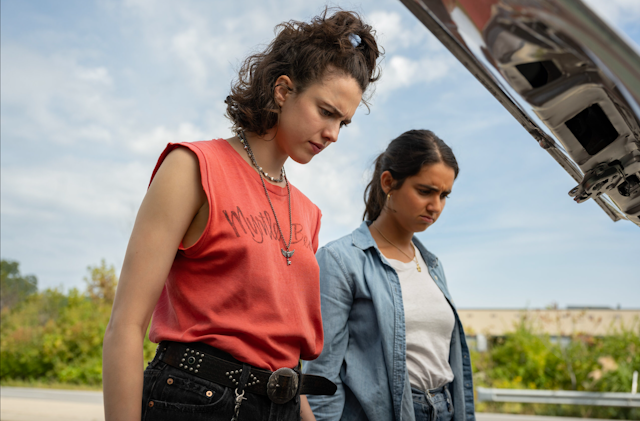The critics are divided: lesbian road-trip caper Drive-Away Dolls is either “furiously funny [and] helplessly horny” or “flimsy and forgettable”. No doubt for audiences the same will be true – some will love it and others will hate it.
I enjoyed this solitary Coen brother (Ethan) outing, co-created with his queer wife Tricia Cooke. But, rather than adding my voice to the critical polarisation, I am more interested in its significance in the history of US lesbian film, and its place as part of a genre of comedy lesbian films that upend previous stereotypes.
Lesbians in US film
Lesbians have been poorly treated in US cinema. We were erased in the era of the Hays Code – a series of censorship guidelines for filmmakers – which existed for 36 years (1930-1966). For almost 40 years, lesbianism was unmarked and unnamed, only ever insinuated and mostly in negative ways.
The most famous example of this is Mrs Danvers in Rebecca (1940), as the plain, repressed and twisted servant whose motivations are an unhealthy infatuation with her beautiful, dead employer, Rebecca. Dracula’s Daughter (1936), the sequel to Dracula (1931), followed in this line of monstrous but unspoken lesbian villains.
The tragic lesbian was another trope, and featured in The Children’s Hour (1961) starring Audrey Hepburn and Shirley MacLaine. Any hint of romantic lesbian feelings are accompanied by feelings of shame, wrongdoing and self-loathing, as MacLaine later discussed regretfully in the documentary The Celluloid Closet.
New Queer Cinema of the 1990s blew up the script, naming and unshaming lesbians. Films like Go Fish (Rose Troche, 1994), The Watermelon Woman (Cheryl Dunye, 1996) and High Art (Lisa Cholodenko, 1998) left stereotypes far behind as young, ethnically diverse women told their own stories. The focus was on their friendships as well as their romantic and sexual relationships. Yet, these were low-budget independent films that were seen by few outside of film festivals and the lesbian and queer community.
While there have been advances in TV representations of lesbians with series such as the L Word and its follow-up, Generation Q – among many others – film has been slower to catch up.
Some exceptions are quality historical dramas such as Carol (Todd Haynes, 2015), Ammonite (Francis Lee, 2020) and Portrait of a Lady on Fire (Céline Sciamma, 2019). While these are valuable contributions to the queer film canon, no one is having much fun, and characters are consigned to the tragic ending determined by the context of the historical periods in which they are set.
When lesbians gain access to the means of storytelling production, we demonstrate the humour and sense of play that has been missing in film, consigning the tragic trope to the bin. Lesbian spy movie D.E.B.S (2004), cult comedy But I’m a Cheerleader (1999) and sci-fi B-movie Codependent Space Alien Seeks Same (2011) are all very silly and very funny.
The recent gay comedy Bottoms (2023) also has a lot of fun with its characters, as two young female college students start their own self-defence fight club in a bid to become popular and have more sex. And hot on its heels now is Drive-Away Dolls, in the form of a lesbian road movie.
Drive-Away Dolls: fun-loving dykes
This brief history of lesbians on screen shows that when gay women tell their own stories in the comedy genre, things are a lot more fun for everybody. Drive-Away Dolls certainly fits this category of lesbian comedy that refuses to take itself seriously.
Two “odd couple” friends, good-time dyke Jamie (a gleeful Margaret Qualley) and introverted book-loving Marian (a hilariously straight-faced Geraldine Viswanathan) take a road trip together using a drive-away (hire) car. Jamie is focused on visiting as many lesbian bars en route in her quest to help Marian have more sex, after a fallow period following a split with her girlfriend.
The two are initially oblivious to a parallel plot involving a mysterious suitcase in the boot (they have been given the wrong car), a chase by hapless, violent thugs to retrieve the case, and a hypocritical Republican politician (played by Matt Damon) whose reputation rests on retrieving the “goods” in the case.
All these plot points provide the ingredients for a comic lesbian road movie caper. There are many phallic gags and the film is deliberately ridickulous (pun intended). Drive-Away Dolls is studiously silly, as the interspersed B-movie style transitions and psychedelic insertions underscore.
While the film has been marketed as a Coen brother film with Ethan in the director’s chair, it is as much Cooke’s film (Coen’s editor-producer wife) as his. The idea for the film came from her student reminiscences of a road trip with a friend.
Drive-Away Dolls was originally Drive-Away Dykes before the production company insisted on the change, and Cooke’s queer world view dominates in the nostalgia for lesbian bars and the riotous sex scenes. But Coen’s signature humour, convoluted plotline, deeply flawed male characters and upending genre tropes (in this case, exploitation movies of the 1960s and 1970s) are in joyful evidence.
The relationship between the two filmmakers is as interesting as the film. Cooke is openly queer and both she and Coen remain happily married, while both are in relationships with other people. Theirs is a creative partnership, working together on the script, directing and editing. It does feel a little off that in a film celebrating lesbian culture and ending the patriarchy, Coen is credited as the sole director – but that says more about the industry than their partnership.
This husband-and-wife team with a difference are now working on their follow-up film, Honey Don’t, which will follow the pulpy tone of Drive-Away Dolls. While the critics may be snooty about its quality, I’m looking forward to it.

Looking for something good? Cut through the noise with a carefully curated selection of the latest releases, live events and exhibitions, straight to your inbox every fortnight, on Fridays. Sign up here.

